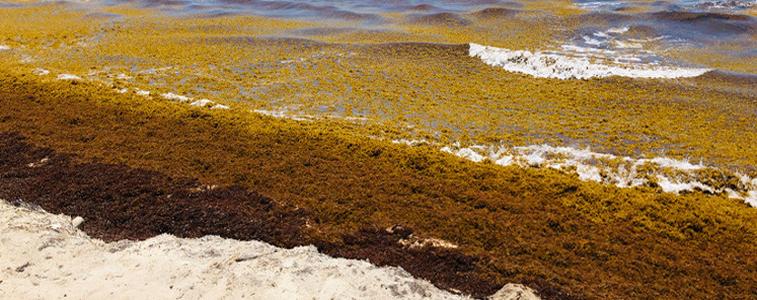 In 2019, we posted about an 8,850-kilometer Atlantic sargassum belt from the Gulf of Mexico to West Africa. The floating mat of the brown buoyant seaweed had a devastating impact on beaches across the east coast of Mexico, the Caribbean, Texas, and Florida. The researchers said that this sargassum belt represented the world’s largest macroalgal bloom and that such recurrent blooms may become the new normal.
In 2019, we posted about an 8,850-kilometer Atlantic sargassum belt from the Gulf of Mexico to West Africa. The floating mat of the brown buoyant seaweed had a devastating impact on beaches across the east coast of Mexico, the Caribbean, Texas, and Florida. The researchers said that this sargassum belt represented the world’s largest macroalgal bloom and that such recurrent blooms may become the new normal.
Now, a new sargassum bloom is befouling pristine beaches on Mexico’s east coast and across the Caribbean, threatening a post-COVID tourism rebound in the region.
Reuters reports that sargassum seaweed, which gives a brown tint to the crystal clear waters of the Caribbean coast and emits a sewage-like stench when it washes ashore, reached an all-time monthly high in June, according to the University of South Florida. There were 24.2 million tons recorded in the month in the Caribbean region, up from 18.8 million tons in May.
Mexico’s GDP from tourism took a 25% hit in real terms in 2020 due to the pandemic, even though the country never closed its borders. In 2021, however, the sector rebounded nearly to pre-pandemic levels, according to the Spanish bank BBVA, which warned the upward trajectory was in danger unless the seaweed is controlled.
Since 2011, seaweed on the east coast of Mexico and across the Caribbean has exploded for reasons scientists do not yet fully understand.
A group of U.S. researchers, however, has fingered a prime suspect: human sewage and agricultural runoff carried by rivers to the ocean.
The science is not yet definitive. This nutrient-charged outflow is just one of several likely culprits fueling an explosion of seaweed in the warm waters of the Americas. Six scientists told Reuters they suspect a complex mix of climate change, Amazon rainforest destruction and dust blowing west from Africa’s Sahara Desert may be fueling mega-blooms of the dark-brown seaweed known as sargassum.
Still, a recent study examining the chemistry of seaweed from the 1980s up to 2019 offers the strongest evidence yet that water coming from city and farm runoff has been a major contributor to the expansion of the so-called Great Atlantic Sargassum Belt, which now stretches for nearly 9,000 kilometers.

In times past, when folk had to work with the natural world to grow food , they used to collect seaweed and spread it on their fields. This rendered habitable many places with impoverished soil and few resources, to support whole villages.
Now, in a time when energy costs are spiralling , input to farms is threatening bankruptcy to many, and food shortages to millions, does this huge mass of rich material present a gift, or only a dramatic nuisance? Might there be some economical way to harvest, dry, compress the stuff and put it to good use? Millions of tons of cheap fertiliser or only a downer for holidaymakers?
@Mike Lee
Yes it can and they can probably use it to make fuel for the trucks to transport it inland.
It also provides an opportunity for eco-tourism, keep fit shoveling it into the trucks instead of lounging round the pool… but that might be stretching the point.